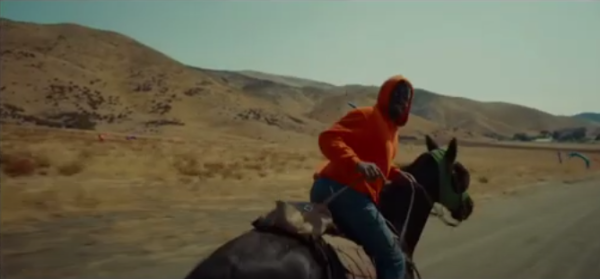The Life of an Artist
Whether someone enjoys works like Harry Potter, The Great Gatsby, Van Gogh paintings, a production of Oliver or even Chris Hasting’s Dr. McNinja, art has touched their life.
But what is the life of an artist like?
Weeks ago on The Daily Show, Jon Stewart was conducting an interview with comedian Robin Williams. After a time the two begin discussing writing and artists. Stewart eventually says, “[Artists] are generally bored individuals. We are working forty minutes a night. in Winnipeg for two straight weeks.” The crowd cheers and John Stewart turns to them and shouts “NO!” It can be surmised that, though working only forty minutes a night, those forty minutes can be a stressful time.
Neil Gaiman, award- winning comic book writer and novelist famously said “Being a writer is a very peculiar sort of a job: it’s always you versus a blank sheet of paper (or a blank screen) and quite often the blank piece of paper wins.” When a writer sits down to write, the story, in a sense, becomes them. On writing a novel, Gaiman wrote “When writing a novel, that’s pretty much entirely what life turns into: House burned down. Car stolen. Cat exploded. Did 1500 easy words, so all in all it was a pretty good day.”
But does that mean the life of an artist is a bad one? To answer, this, a basic question must be answered: what is an artist?
“An artist is someone who takes time out to create something. For example, my elementary school art teacher, Mrs. Dangora did not make us artists because we were all forced to make the same thing,” says Aidan Gorrell, a poet, actor, novelist and playwright. Most seem to agree with this definition; however the exception to this rule is that an artist must have something to say. Aidan Gorrell went on to say, “Nonsense with a good rhyming scheme is still nonsense. I think most art needs a meaning behind it.”
That means anyone can be an artist. Getting paid? Not a factor. Being published? Doesn’t matter. Just create. And create with a purpose. As Rachel Smith, Pentucket junior, writer and novelist says, “An artist is someone that can take nothing and, out of it, create something amazing.”
That said, it is agreed that a there is a golden rule of not trying to imitate others. “If every band was a copy of another one, life would get pretty boring.” Aidan Gorrell said. If everyone just tries to imitate each other, nobody would try to go beyond the realm of the possible by attempting the impossible, and art would never advance.
Now what about improvement? How can an artist tell if they’ve improved or they’re “ready” to try something new? Novelist Benjamin Yosua- Davis says, “To a certain extent, I think that we’re all just “becoming artists”, never arriving, all on different stages of the journey.” In other words, any form of art is like a path. The artist is walking toward a mountain at the end of the path—their goals. Most people in High School and College are just beginning to learn how to walk, much less tread the path itself. Sure, teenagers and young adults have improved miles since they began, but they still have a long way to go.
But why do it? Why create? As Natalie Pelletier (Writer/artist extraordinaire) put it, “In everyday life, it can be hard to pay attention to things when all you want to do is grab a pencil and write or draw or just stop whatever it is you’re supposed to be doing and grab a hot glue gun. It’s also tough when no one understands what you’re doing, or they see a drawing of something kind of strange and make fun of you.” So why do it?
Unfortunately, there is no clear cut answer. Benjamin Yosua- Davis likes to create because he thinks “I’m getting in touch with something far bigger than myself – and, that, perhaps, in some small way, the way I put words to paper shares the same creative power that set the universe in motion.” While others agree with this, more still create because they like stringing words together and making a sculpture or a drawing. Some people create just to create. Others use it as a coping mechanism.
Yet the one thing all artists share is passion. As Rachel Smith put it, “Sometimes I just scroll through all the pages of my novel and look at the type there and realize that I put all those words in that document to form a coherent, cohesive plot. It’s an indescribable feeling of pride.”
Mr. Yosua- Davis went on to say, “As a child, my parents always encouraged me to be creative. They still have copies of the poems and stories I wrote when I was six or seven (and let me tell you, “The Teenage Mutant Ninja Turtles Get Tricked Into Going to Saudi Arabia has all the hallmarks of a classic). Permission is so important for a young artist – to just get the chance to create, just for creation’s sake, not for anything else. I’m grateful that my parents gave me all the permission in the world when I was young.” Childhood expression forms passion, which flares and turns into something amazing.
But what about the aforementioned ‘making fun of you’? How does that affect an artist? Natalie Pelletier says of her role model, Jason Iscariot, “He creates solely based on what he wants to do, but the feedback he gets from his fanbase or critics is always taken into account. He doesn’t get all offended and angry if someone says ‘Ugh your music sucks.’ His response is, ‘Well that doesn’t help me. How can I make it not suck?’
“He works on his weaknesses and always improves based on the criticism that he receives, and I think that that’s crucial, because if you just ignore what people tell you in order to spare your own squishy little feelings, you will never grow as an artist.” In short, making fun of an artist does not help them, however, an artist should not confuse criticism with bullying.
The life of an artist is a hard one, filled with mistakes, succeeding, failing and trial and error. That said, it’s a fun one, filled with creation and paint brushes and marvelous words and images. They make something out of nothing. And with a lot of hard work, time, and a little luck, an artist can share something amazing with the world.





